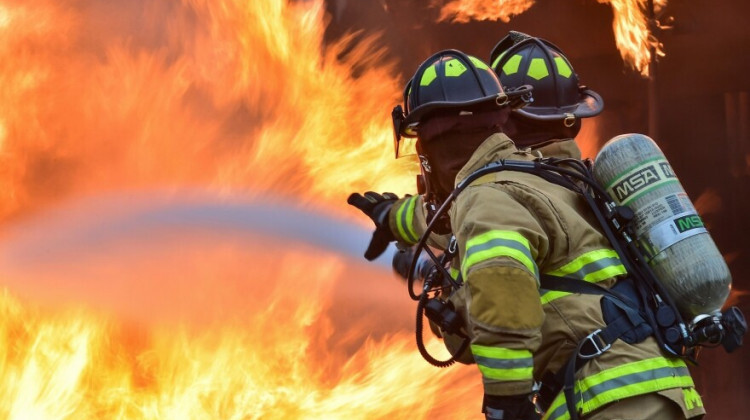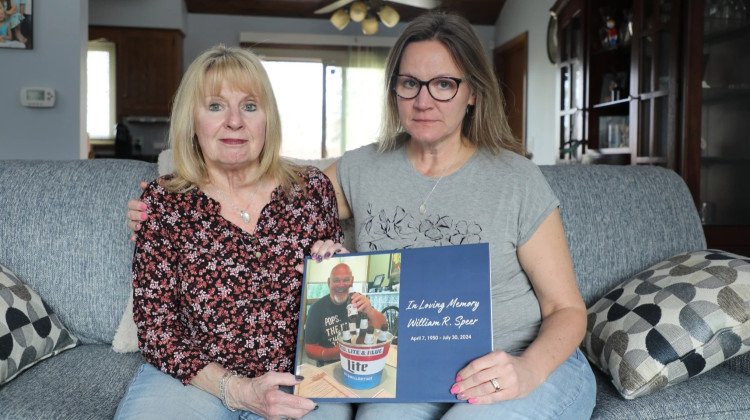
Cancer is the leading cause of occupational death for firefighters. Compared to the general population in the U.S., they have a 9 percent higher chance of having cancer and 14 percent higher chance of dying from it.
U.S. Navy Mass Communication Seaman Barry Riley / Creative CommonsThe very same gear that protects firefighters from harm also endangers their health. PFAS, also known as “forever chemicals,” have been found in jackets and other layers of protective equipment for first responders.
Exposure to PFAS has been linked to several types of cancer and other health issues. Cancer is the leading cause of occupational death for firefighters. Compared to the general population in the U.S., they have a 9 percent higher chance of having cancer and 14 percent higher chance of dying from it.
Now a new state testing program aims to improve the understanding of the link between PFAS and cancer rates amongst firefighters.
Through the new Indiana Firefighter PFAS Biomonitoring Pilot Program participants will receive a test kit in the mail to collect a drop of blood and send it to the lab for tests to be run on. The program was created in 2023 through new state legislation.
Indiana State Fire Marshal Steve Jones said there’s a questionnaire that goes along with the test.
“So we know you know whether they're a career, whether they're a volunteer, whether on the hazmat team or whether they're on an airport, firefighting department, how many exposures, how many fires, we think that they've been involved in,” Jones said.
That baseline history can then help draw conclusions from test results.
“It's really important for us to be able to take this first step to understand the risk from exposure, based on what we will find and learn from the level of PFAS and firefighters blood,” said Tony Murray, president of Professional Fire Fighters Union of Indiana.
He said the program will help the state learn more about occupational risk. The program calls for 1,000 firefighters across the state to be tested but current limited funding of $200,000 might make that goal challenging.
“We don't think that we will have the funding to see all 1,000 tested, but we will work on that in the future, I think that we can help to advocate for additional funding,” Murray said.
Both Murray and Jones both want to see more testing opportunities in the future.
“We've gotten a lot of firefighters entering to have; offering to have their blood tested,” Jones said.
“It's been overwhelming. But I encourage all the firefighters to continue to put information in,” he said. “Because if we do have additional funding, are there other questions based on the results, we will already have a database of people that are interested in the program itself.”
Initial testing data is expected to come out by the end of the year, but Jones said even without that research the state is already working to reduce exposure in fire departments across the state.
That includes a take-back program for Aqueous film forming foam, used to fight fires but containing PFAS. Jones said the state has picked up more than 40,000 gallons of the foam to dispose of.
The foam is still used for now in some areas including aviation to extinguish jet fuel fires until a safe alternative can be developed.
While there are currently no PFAS free alternatives to some of the industry required gear, a new state law requires purchased firefighter gear to have a permanent label on it noting if it contains PFAS.
“We're working with industry partners, and our International Association of Firefighters to find ways to bring firefighting gear to market that does not contain PFAS, but also keeps the same level or greater level of protection to firefighters who count on that gear to do their jobs,” Murray said.
While industry standards have more work needing to be done, Murray said he’s seen progress in getting firefighters to complete an annual physical that could help with early detection.
Hoosier firefighters can sign up for the testing program on the Indiana Department of Homeland Security’s website.
The deadline to register is August 9th.
Contact WFYI Reporter Samantha Horton at shorton@wfyi.org.
 DONATE
DONATE






 Support WFYI. We can't do it without you.
Support WFYI. We can't do it without you.